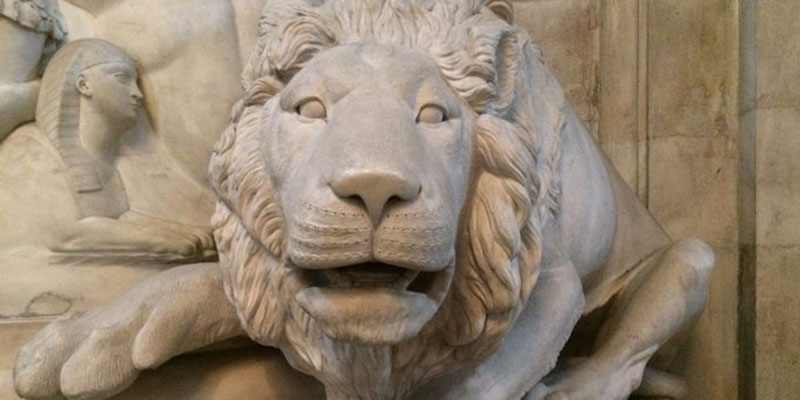Reinterpreting the sculptural collection at St Paul’s Cathedral
-
Research
- Culture and Communication
Posted on 17 November 2020
As the future of public monuments hangs in the balance, our researchers reinterpret the history of 200 monuments at St Paul’s Cathedral.

The lion from John Flaxman's memorial to Admiral Lord Nelson (after 1805).
The monuments and memorials are an unmissable and fascinating part of any visit to the Cathedral, significant both as works of art and as a record of Britain's national and international aspirations in the long 19th century. We felt now, more than ever, was the time to retell their story.
The toppling of the statue of slave trader and philanthropist Edward Colston into Bristol harbour by protestors in the summer of 2020 represents, perhaps, one of the most iconic images of the year.
Responding to the murder of George Floyd and the Rhodes Must Fall movements that originated in Cape Town and Oxford, the fall of Colston has generated a heated debate about public monuments in Britain and its former colonies. These far-reaching debates form part of a major reconsideration of how the history of colonialism and slavery are portrayed, especially through public art.
Ambitious works
St Paul’s Cathedral is home to one of the most important, permanently displayed collections of British 19th-century sculpture. In 1796 the first modern monument was erected on the Cathedral floor. It was followed by a further 77 large monuments before 1913, when the Dean and Chapter, concerned about overcrowding, announced that they wouldn't accept any more.
Over this period the cathedral became home to some of the best and most ambitious works of sculpture by the period’s foremost artists. Renowned sculptors rose to the challenge of creating art that could decorate the building, respond to the other monuments, and carry out the task of remembering an individual or group of people for posterity.
Individuals commemorated included soldiers, sailors, artists and writers, astronomers, musicians and composers, statesmen, journalists, clergy and philanthropists. Sculptural styles varied from the Baroque allegorical group, and the stern standing figure, through the revival of Gothic reclining figures, to mural monuments based on contemporary photographs and newspaper engravings.
So, what might the collection tell us about some of the long 19th century’s most pressing questions, about faith, science and spirituality, philanthropy and colonial rule, and what might appropriate research on such monuments look like today?
Significant
Through the Pantheons project, a team of art historians from the Department of History of Art at the University of York is working to reinterpret the Cathedral monuments in the period between 1795 and 1914, commemorating some of Georgian, Victorian, and Edwardian Britain's most significant figures.
Simon Carter, Collections Manager at St Paul’s, said: “The monuments and memorials being reassessed by the Pantheons project are an unmissable and fascinating part of any visit to the Cathedral, significant both as works of art and as a record of Britain's national and international aspirations in the long 19th and early 20th century. We felt now, more than ever, was the time to retell their story.”
In light of a changing public attitude, the Pantheons project asks what role the collection played in British, European, and imperial art history in the long 19th century. What does it tell us about the history of Britain as a nation and imperial power between 1795 and 1914, and how has the collection been viewed, and its character changed, from the arrival of the first monuments in the midst of the French Revolutionary and Napoleonic Wars?
Deeper understanding
Professor Jason Edwards from the Department of History of Art said: “We are delighted to be working with colleagues at St Paul’s to improve the information and interpretation available to those responsible for the care and presentation of the collections, and to the public more generally.
“We hope to cement the status of long 19th-century sculptures as perhaps the key artistic medium for thinking about British national and imperial identity, complementing other mediums such as painted portraits, landscapes, graphic satire, and photography.”
The three-year project, which began in October 2019, will bring the sculptures to life with new photographs, short films, and a host of open-access digital resources available to the public. A new guidebook will be published in 2021, alongside a 50 Monuments in 50 Voices book, in 2022, featuring verbal and visual responses to the collection from artists, activists, academics, and others from across the world.
At the centre of the project will be a new, fully searchable database, cathedral ground plan, and atlas enabling real-life and virtual visitors to visualise the arrival and concentration of new monuments on the cathedral floor and in the crypt. The project takes the monuments seriously as works of art, considering their iconography and materiality, their style and substance, as well as what it means to encounter such monuments in one of the most significant Protestant cathedrals in the world.
The team will also contribute to a new BBC4 documentary about the history and contested status of monuments in our time.
Janina Ramirez, the project’s media advisor, explains: “While the UK's galleries and museums are full of treasures and recognised for their importance, the sculptural collection at St Paul’s is rarely seen this way. And yet it contains the most extraordinary array of sculptures commemorating those who wielded power and influence through a turbulent time of empire, expansion and industrialisation.
“Some of the finest sculpture of the 19th century was created to sit within St Paul’s and yet it has received little attention. The Pantheons project will right this wrong, documenting and scrutinising the works, while also engaging with the sculptures on an international platform for the first time.”
More information
The text of this article is licensed under a Creative Commons Licence. You're free to republish it, as long as you link back to this page and credit us.

Jason Edwards
Professor Jason Edwards works primarily on the sculptural pantheon at St Paul's Cathedral, British art in its global and imperial contexts, the art of Anglo-India, and British Orientalism in the period between 1760 and 1914.

Richard Johns
Dr Richard Johns' research centres on art and visual culture in Britain during the long 18th century, with a special interest in grand-scale decorative history painting.

Amy Harris
Dr Amy Harris' research centres on late 18th to early 20th century British sculpture, the visual legacy of the British Empire, biography, national identity, and the history of collections.

Greg Sullivan
Dr Greg Sullivan is an art historian and curator specialising in British sculpture from the late 17th to the mid 19th centuries. His current research interest is in the intersection of sculpture and the history of geology in the 18th and 19th centuries.
Explore more research

A research project needed to spot trees on historic ordnance survey maps, so colleagues in computer science found a solution.

We’re using gaming technology to ensure prospective teachers are fully prepared for their careers.

A low cost, high-accuracy device, could play a large part in the NHS's 'virtual wards'.
